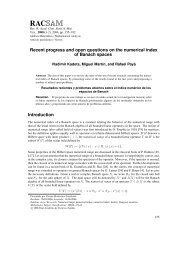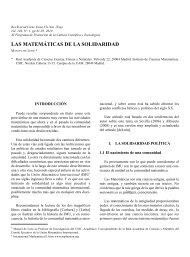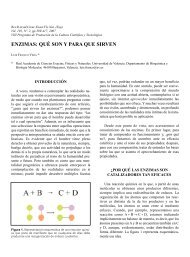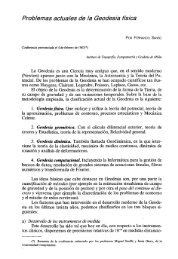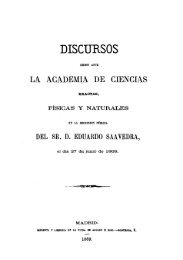Holomorphic Functions
Holomorphic Functions
Holomorphic Functions
You also want an ePaper? Increase the reach of your titles
YUMPU automatically turns print PDFs into web optimized ePapers that Google loves.
(Ultra)distributions of L p-growth as boundary values of holomorphic functionsPROOF. In fact, T is nothing else but the restriction of the boundary value operator considered in [17] and[22]. Now it is enough to proceed as in the first part of the proof of Theorem 3 in [8]. Next, we show that the boundary value of a function in Hω N ∗ ,p is an (ultra)distribution of L p -growth.Proposition 1 T (H N ω ∗ ,p) is contained in (D Lp ′ ,(ω)(R N )) ′ with 1 p + 1 p ′= 1. Moreover,T (f) = lim∑(ɛ→0 +σ∈{−1,1} N j=1in the weak topology σ((D Lp ′ ,(ω)(R N )) ′ , D Lp ′ ,(ω)(R N )).N∏σ j )f(x + iσɛ)PROOF. First we assume that N = 1 and that ω is a weight function. Given f ∈ Hω 1 ∗ ,p we choose k ∈ Nand C > 0 such thatmax(‖ f(· + iy) ‖ ∞ , ‖ f(· + iy) ‖ p ) ≤ Ce kω∗ ( y k ) (1)for 0 < y < 2. Without loss of generality we may assume that f ≡ 0 in the lower half-plane. We willshow that {f(· + iɛ) : 0 < ɛ < 1} is a bounded set in (D Lp ′ ,(ω)(R)) ′ and that T (f) ∗ ϕ ∈ L p (R) forevery ϕ ∈ D (ω) (R). We put f iɛ (x) := f(x + iɛ). Let ϕ ∈ D (ω) (R) be given and let b > 0 be such thatsupp ϕ ⊂] − b, b[. By [17, 3.4] we find φ ∈ D((−b, b) × (− 1 2 , 1 2)) such that(i) φ |R = ϕ∣ (ii) sup∂∣∂¯z φ(x + iy) ( ∣∣∣ |y|ekω∗ k ) < ∞.z∈C\RApplying Stokes’ theorem to the function θ x (ξ) := f(ξ + iɛ)φ(x − ξ) in the rectangle D x := [x − 2b, x +2b] × [0, 1] we get that∫(f iɛ ∗ ϕ)(x) = 2i f(x − t + i(v + ɛ)) ∂ φ(t − iv) d(t, v).∂¯zDDwhere D := [−2b, 2b] × [0, 1]. Therefore∫∣ ∣ ∣∣∣ ∂ ∣∣∣‖ f iɛ ∗ ϕ ‖ p ≤ 2 ‖ f(· + i(v + ɛ)) ‖ p∂¯z φ(t − iv) d(t, v),from where we conclude that {f iɛ ∗ ϕ : 0 < ɛ < 1} is a bounded set in L p (R), which shows that {f iɛ :0 < ɛ < 1} is bounded in (D Lp ′ ,(ω)(R)) ′ ([2]), hence equicontinuos. Moreover, for every null sequenceof positive numbers (ɛ n ) n one has (T (f) ∗ ϕ)(x) = lim n (f iɛn ∗ ϕ)(x) pointwise and there is C > 0with |(f iɛn ∗ ϕ)(x)| ≤ C for every n ∈ N and each x ∈ R. Using Lebesgue’s dominated convergencetheorem we get that {(T (f) ∗ ϕ)χ [−n,n] : n ∈ N} is bounded in L p (R), hence T (f) ∗ ϕ ∈ L p (R)and T (f) ∈ (D Lp ′ ,(ω)(R)) ′ . Let us take a 0-neighbourhood V in D Lp ′ ,(ω)(R) such that T (f) ∈ V o andf iɛ ∈ V o for 0 < ɛ < 1 and let τ denote the topology of pointwise convergence on the dense subspaceD (ω) (R) of D Lp ′ ,(ω)(R). Then the weak topology and τ coincide on the equicontinuous set V o . Since< T (f), ϕ >= lim ɛ→0∫R f iɛ(x)ϕ(x)dx for every ϕ ∈ D (ω) (R) we get that T (f) is the limit of (f iɛ ) inthe weak topology.If ω(t) = log(1 + t), given ϕ ∈ D(R) we choose k ∈ N satisfying (1) and we putThen ∂φ∂¯z (x, y) = 1 2φ(x, y) :=k∑j=01j! ϕ(j) (x) (iy) j .ϕ (k+1) (x)(iy) k and we proceed as above. See [16, 2.2].k!249





